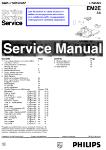Текст
2. PROGRAMMING
2.1 Programming Procedure
2.1.1 Initial Set-Up
Turn the HX240 power off and remove the battery
pack, the jack caps (external microphone/speaker and
power supply) and antenna from HX240 before
programming.
a) Remove the four screws@and(B)from the HX240,
and open the front case carefully as shown in the
illustration.
Figure 2-1.
b) Set the program switch S602 to its ”PRG” (program)
position.
c) Reassemble the HX240, and set a charged battery
pack.
d) Turn the power on while holding the scan and key
lock switches pressed.
After a few seconds, all digits on the channel display
will appear. After released the scan and key lock
switches and the channel display will show as
follows;
The HX240 is now in the programming mode.
Figure 2-2.
Function of Switches in the Programming Mode Table 2- 1.
Switch Function
Lamp Switch moves to the next Programming step.
Monitor Switch stores data into memory of HX240 microprocessor.
Channel Selector changes displayed information.
Key Lock Switch deletes the displayed information.
PTT Switch if held depressed while sele cting the receive or transmit frequen cies with the channel selector, the d isplayed frequency changes in 1 MHz steps.
- To Clear All Channel Information -
Perform the following steps only if you desire to clear
all channel information.
a) Set the Back-Up switch S601 to its "OFF” position.
b) Turn the HX240 power on for approximately ten
seconds then turn the power off again.
c) Set the battery pack.
Turn the HX240 power on, then set S601 to its ”ON”
position.
d) Verify that "CL” is appeared on the channel display.
NOTE : If S601 is left in the "OFF" position, all
programmed data will be lost.
e) Turn the HX240 off.
- To Set the Tuning Step -
The programmed tuning step in this section affects all
channels in programming.
After entered the p rogrammed mods press the lamp
switch.
The channel display will show the tuning step rate
(5 kHz).
BLINKS
Figure 2-3.
a) Rotate the channel selector control to a desired
tuning step rate (5,10,12.5, 25 or 50 kHz).
NOTE : if selected 12.5 kHz, the display shows
”cs12M”.
b) If the tuning step rate is correct, press the monitor
switch to store the tuning step rate. The ”cs" on the
channel display will stop blinking, indicating that the
tuning step is stored.
c) If you wish to change the stored tuning step rate in
step(b), rotate the channel selector control.
The "cs” on the channel/display will start blinking.
Select a new tuning step rate desired and press
the monitor switch to store it. The "cs” on the
channel display will stop blinking.
- To Set Time Out Timer -
The programmed time out timer duration time in this
section affects all channels.
After the tuning step is stored, press the lamp switch.
The channel dispaly will show the current time out timer
duration time.
Figure 2-4.
This is the duration of the transmit Time Out Timer.
”0.0” means that the Time Out Timer is inhibited,
a) Rotate the channel selector control to select the
duration time desired. The duration time changes in
increments of 0.5 minutes up to a maximum of 8.5
minutes.
b) If the duration time is correct, press the monitor
switch to store it. The ”00” on the channel display
will stop blinking, indicating that the duration time is
stored
c) If you wish to change the stored duration time in
step (b), rotate the channel selector control. The
”00” on the channel dis play will start blinking. Select
a new duration time de sired and press the monitor
switch to store it. The ”00” on the channel display
will stop blinking.
2.1.2 Channel Frequency
This section consists of three setting mode (Channel
Number, Receive Frequency and Transmit Frequency).
Up to sixteen channels can be programmed.
One frequency can be programmed for transmit and
another receive on each channel. Receive-only
channels can be programmed but not transmit-only
channel. The programmable receive and transmit
frequency is from 150.000 MHz until the maximum of
174 000 MHz.
- To Set Channel Number -
Aft erth etime oil timerd urd’ion time’is stored, press
the lamp switch and the channel display will show the
channel number "01 ”. This is the entry point for ”CH01 ”
values.
Figure 2-5.
a) Rotate the channel selector control to select a
channel number desired.
b) Press the monitor switch to store the selected
channel number. The ”CH” on the channel display
will stop blinking indicating that the channel number
is stored.
c) If you wish to change the stored channel number in
step (b), rotate the channel selector control.
The ”CH" on the channel didsplay will start blinking.
Select a new channel number desired and press the
monitor switch to store it. The "CH” on the channel
display will stop blinking.
- To Set Receive Frequency -
After stored the channel number, press the lamp
switch.
The channel display will show the current receive
frequency, if no receive frequency has been
previously programmed, the channel display will show
as follows :
Figure 2-6.
a) Rotate the channel selector control to select the
receive frequency desired. The frequency will
change according to the programmed tuning step.
If the channel selector is rotated while holding the
PTT switch depressed, the displayed frequency will
change in 1 MHz steps.
NOTE'.The HX240Vwil normally have a 5 or10
kHz tuning step. If a tuning step of 12.5, 25
or 50 kHz is selected press the key lock
switch to clear the channel display before
selecting the desired receive frequency.
If a tuning step of 5 or 12.5 kHz is selected,
”L”, ”M” and ”H" will show on the channel
display in place of 2.5, 5 and 7.5 kHz
respectively.
Examples;
Frequency (MHz) Channel Display
160.0125 160.01 L
160.025 160.02 M
160.0375 160.03 H
b) Press the monitor switch to stor e the selected
receive frequency. The on t he channel display
will stop blinking, indicating tha t tie receive
frequency is stored.
c) If you wish to change the stored receive frequency
in step (b), rotate the channel selector control. The
on the channel display will start blinking. Select a
new receive frequency desired and press the
monitor witch to store it. The on the channel
display will stop blinking.
-To Set Receive CTCSS Tone Frequency-
a) After stored the desired receive frequency, press
the lamp switch. The channel display will show
the current receive CTCSS tone frequency.
If on receive CTCSS tone frequency has been
previously programmed, the channel display will
show as follows :
«3 )>
L
Figure 2-7.
NOTE : “C” indicates carrier squelch operation.
b) Rotate the channel selector control to select the
receive CTCSS tone frequency desired.
The frequency will change according to the CTCSS
tone frequencies listed in Table 2-2.
CTCSS Tone Frequencies Table 2- 2.
67.0 97.4 136.5 192.8
71.9 100.0 141.3 203.5
74.4 103.5 146.2 210.7
77.0 107.2 151.4 218.1
79.7 110.9 156.7 225.7
82.5 114.8 162.2 233.6
85.4 118.8 167.9 241.8
88.5 123.0 173.8 250.3
91.5 127.3 179.9
94 8 131 8 186 2 (UNIT.' Hz)
These are based on El A Standard RS - 220A.
c) Press the monitor swi tch to store the selected
receive CTCSS tone frequency.
The “.” on the channel display will stop blinking
indicating that the tone frequency is stored.
d) To change the stored CTCSS tone frequency, rotate
the channel selector control.
The “.’’on the channel display will start blinking.
Select the new CTCSS tone frequency and press
the monitor switch to store it. The “."on the channel
display will stop blinking.
- To Set Transmit Frequency -
After stored the receive CTCSS tone frequency,
press the lamp switch. The channel display will
show the current transmit frequency. If no transmit
frequency has been previously programmed, the
''ch annd d’lsp ay wll sh ow as follows :
Figure 2-8.
a) Rotate the channel selector control to select the
transmit frequency desired. The transmit frequency
will change according to the programmed tuning
step. If the channel selector control is rotated while
holding the PTT switch depressed, the displayed
frequency will change in 1 MHz steps.
b) Press the monitor switch to store the selected
transmit frequency. The ”!’ on the channel d’isp ay
will stop blinking, indicating the transmit frequency is
stored.
NOTE : The HX240V will normally have a 5 or 10
kHz tuning step. If a tuning step of 12.5,25
or 50 kHz is selected, press the key lock
switch to clear the channel display before
-x selecting the desired transmit frequency. If a
tuning step of 5 or 12.5 kHz is selected, ”L”,
”M” and ”H” will show on the chann el display
in place 2.5, 5 and 7.5 kHz respect’ ively.
Exa nip es:
Frequency (MHz) Channel Display
160 0125 160.01 L
160.025 160.02 M
160.0375 1 60.03 H
p-4f you wish to change the stored transmit frequency,
otate the channel selector control. Th e”onth e
channel d’ isplay will start blinking. Select a new
transmit fr equency and pess tb mom iJr switc h
to store it. The ”.” on the channel display will stop
blinking.
To Set Transmit CTCSS Tone Frequency-
a) After stored the desired transmit frequency, press
the lamp switch. The channel display will show the
current transmit CTCSS tone frequency. If no
transmit CTCSS tone frequency has been
previously programmed, the channel display will
show as follows:
---BLINKS
Figure 2- 9.
NOTE : “C" indicates carrier squelch operation.
b) Rotate the channel selector control to select the
trans mit CTCSS tone frequency desired.
The frequency will change according to the CTCSS
tone frequencies listed in Table 2-2.
c) Press the monitor switch to store the selected
transmit CTCSS tone frequency.
The on the channel display will stop blinking
inafca tig tha t the bne fequency is stored.
d) To change the stored CTCSS tone frequency, rotate
the channel selector control.
The on the channel display will start bl inking.
Select the new CTCSS tone frequency a nd press
the monitor switch to store it. The on the channel
display will stop blinking.
After stored the transmit CTCSS tone frequency,
press the lamp switch to advance to the next higher
channel number entry point.
- To Leave the Programming Mode -
a) Turn the power off, and remove the battery pack.
b) Remove the four screws@and(B)from the HX240,
and open the front case carefully as shown in
Figure 2-1.
c) Set the program switch S602 to its ”RAD” (radio)
position.
Verify that the back-up switch S601 is set to its
” ON” position.
N OTE : If the back- up switch S601 is not set to
’’ON" position after programmed, the HX240
does not operate.
d) Reassemble the HX240.
e) Normal radio operation will occure on the next
power up.
3




